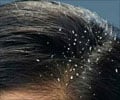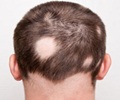The madness of modern day life takes its toll, hair loss being the least of them. Here's all you need to know on hair loss and baldness!!
HAIR is something we don’t take seriously until we start losing it! Fashion magazines tell us how to style and restyle hair, what’s “in” each season – the short hairstyles or the long hairstyles. Both sexes, spend long hours in salons or parlors to groom and to style their mane to perfection. The hair atop the head is no longer a mere extension of the human anatomy; it has, with passing years, metamorphosed into a fashion accessory with the potential to speak volumes on behest of the owner.
But for those who are rapidly losing their hair, it is, indeed, a continuous ‘bad hair day’! Agonizing hours are spent before the mirror contemplating remedial measures. Several of them suffer from insomnia and heartache and many more are known to shun the company of men, as their confidence takes a beating. It is important for these individuals to understand the nuances of hair loss and to tackle it appropriately in order to get on, unhindered, with their day-to-day existence.On Hair and Hair Loss
Each hair strand is composed of 2-3 entwined layers of the protein “keratin”, arising from a follicle embedded in the dermis of the skin.
Natural hair growth is a quick and continuous process. A single hair strand grows 0.44mm per day which is 4 times the growth rate of nails; but we also lose 70 to 150 of hairs strands daily. Having said that it is important to understand that excessive thinning of hair is a serious medical issue rooted in several underlying causes.
Types and Causes for Hair Loss
The type and mode of hair loss generally depends on the reason behind the condition.
• Generalized Hair Loss: This refers to an identical thinning of hair all over the scalp; normal hair growth is not seen on the scalp at all. The reasons for such hair loss include protein, vitamin, or iron deficiency, thyroid disorder, toxin exposure (like thallium sulfate found in rat poison), side effect of medical treatments such as chemotherapy or even excess emotional stress. In this case, hair follicles go into a “resting period” and hair loss becomes apparent only after 2-3 months when the existing hair strands fall.
• Patchy Hair Loss: Here, balding appears only in certain select portions of the scalp while the rest of the scalp retains its natural hair growth. It can be due to ringworm infection (children are mostly susceptible to it) or it may be due to alopecia areata which is a temporary condition resulting in hair loss in patches, the cause for which is still not clear. People with a family history of this condition are obviously more prone, while some evidences suggest that the condition is an autoimmune disorder. Alopecia aereata is associated with an increased risk of developing other autoimmune diseases, such as Systemic Lupus Erythematosus (SLE).
• As one patch regrows hair, a new patch may appear. It can be permanent if it occurs at an early age and may persist over long periods of time covering a major portion of the scalp.
• Hereditary Balding is a condition prevalent in men and women, although women don’t become completely bald. Also called androgenetic alopecia, this condition is X-linked and can be inherited from either the mother or the father. The male sex hormone, androgen, particularly DiHydroTestosterone (DTH) depletes in quantity and this has a direct impact on hair growth and loss.
• The process starts at an early age, sometimes even in adolescence.
• Alopecia totalis causes permanent full-scalp baldness. Alopecia universalis results in complete hair loss throughout the body.
Hair Regrowth: Is it Possible?
Restoring lost hair depends on the type and reasons leading to excess hair fall. Hair restoration can be understood under separate headings:
a) Generalized hair loss, in a vast majority of cases, enjoys natural regrowth as the hair roots have escaped damage.
b) Patchy hair loss due to alopecia areata is not curable but the condition generally disappears by itself within a year. Anti-ringworm treatment can successfully cure any hair loss caused by ringworm infection.
c) Hereditary Balding can be dealt with (to a certain extent!) in any of the following ways
• Camouflage/Concealment techniques include a “comb over” (combing the remaining hair over the bald area), using toupees and hairpieces (wigs) and hair weaving (braiding artificial hair into remaining hair).
• Cosmetic Surgery techniques include Hair Transplantation (transplanting root-bearing scalp to the bald patches), Scalp Flap Transfer (used to cover large patches of baldness), Skin expansion (expanding hair-bearing scalp using a process involving saline injections) and Serial excision (removing bald scalp and pulling the remaining portion of scalp in closer).
• Drug Treatments such as the use of approved medications like Minoxidil (a lotion application on the scalp to encourage hair growth) and Finasteride (an enzyme inhibitor administered as oral medication; not prescribed for women). Both medications come with restrictions in usage and their accompanying baggage of side-effects.
How do I prevent possible Hair Loss?
Slowing down (and possibly preventing) hair loss ultimately boils down to the three “healthy lifestyle” mantra which can help immensely include:-
• A nutritional diet regime (with adequate vitamins, iron and protein),
• Aerobic exercise and
• Cutting down on stress levels.
Some of the other useful tips are as follows-
• When caring for your hair, avoid forceful combing (especially when the hair is wet)
• Use wide-toothed combs.
• Avoid unhealthy hair treatments such as perming, dyeing, curling, straightening, bleaching and machine drying as they help to aggravate hair damage.
• Women can restyle their tresses from ponytails and braids to a more lose, open hairstyle (and the free-spirited look is an added advantage!)
• Avoid unnecessary medications some of which are known to reduce hair loss considerably. Minoxidil and Finasteride are known examples.
Home Remedies for Hair Loss
These days, several products for hair loss are aggressively marketed and are available at every nook and cranny of every place. But why not go natural and try out Mother Nature’s own remedies? Forget those artificial chemicals and try whipping up the perfect formula for hair re-growth in your kitchen!
A few widely recommended home remedies are mentioned below.
• Soak fenugreek or rosemary leaves in water overnight; the next day, smear this water on the scalp.
• Massage the scalp with red henna, castor oil, olive oil or even a raw egg yolk. This is known to improve circulation and promote hair growth.
• Using coconut milk or tender coconut water to wash hair is also a very popular method to prevent hair loss.
If you notice undue hair fall, tufts of your hair on the pillow, thinning of hair or excess shedding when combing or washing, consult an experienced dermatologist specializing in hair care and hair loss treatments. Prompt action yields the best results!
To sum it up....
A naked pate is more socially acceptable now than ever before- a lot of macho movie stars sport it too! Growing a beard may be a solution but only for those who are so inclined. This may help to recover lost ground, by and large! You may also choose to ‘come clean’ with a tonsured look. All this depends on individual preferences.
Don’t allow a bald pate to steal your charm. Live life to its fullest – with hair or without!
Source-Medindia
TANYA/L














